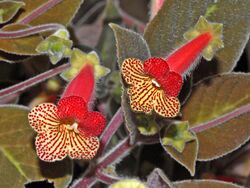Biology:Kohleria
| Kohleria | |
|---|---|

| |
| Kohleria amabilis var. bogotensis | |
| Scientific classification | |
| Kingdom: | Plantae |
| Clade: | Tracheophytes |
| Clade: | Angiosperms |
| Clade: | Eudicots |
| Clade: | Asterids |
| Order: | Lamiales |
| Family: | Gesneriaceae |
| Subfamily: | Gesnerioideae |
| Genus: | Kohleria Regel[1] |
| Species | |
|
See text. | |
| Synonyms[1] | |
| |
Kohleria is a New World genus of the flowering plant family Gesneriaceae. The plants are generally tropical herbs or subshrubs with velvety stems and foliage and brightly colored flowers with spots or markings in contrasting colors. They are rhizomatous and commonly include a period of dormancy in their growth cycle. The genus was revised in 1992 and was then recognized as having 19 species distributed in Central America and South America. phylogenetic in 2005 indicated that the epiphytic genus Capanea is derived from within Kohleria, and the two species of Capanea were subsequently transferred to Kohleria. The genus Pearcea is closely related.
Because of their colorful and exotically patterned flowers, as well as a general interest in the many tropical flowering plants that were being introduced from the Americas, kohlerias were very popular in England and Europe in the 19th century. Many species and hybrids were lavishly illustrated in horticultural magazines such as Curtis's Botanical Magazine under the discarded or erroneous names of Achimenes, Gesneria, Isoloma, Sciadocalyx, and Tydaea. These species and hybrids almost entirely disappeared in the early 20th century, and plant breeders have only recently begun to work extensively with this genus again.
Several species are widespread, variable, weedy, and tend to hybridize in the wild, and numerous names have been described that are synonyms of other species or are hybrid taxa.
Selected species and varieties
(As of April 2021), Plants of the World Online accepted the following species:[1]
- Kohleria affinis (Fritsch) Roalson & Boggan (syn. Capanea affinis)
- Kohleria allenii Standl. & L.O.Williams
- Kohleria amabilis (Planch. & Linden) Fritsch
- Kohleria anisophylla (Fritsch) Wiehler
- Kohleria bella C.V.Morton
- Kohleria diastemoides L.P.Kvist & L.E.Skog
- Kohleria × gigantea (Planch.) Fritsch
- Kohleria grandiflora L.P.Kvist & L.E.Skog
- Kohleria hirsuta (Kunth) Regel
- Kohleria hondensis (Kunth) Regel
- Kohleria hypertrichosa J.L.Clark & L.E.Skog
- Kohleria inaequalis (Benth.) Wiehler
- Kohleria longicalyx L.P.Kvist & L.E.Skog
- Kohleria neglecta L.P.Kvist & L.E.Skog
- Kohleria peruviana Fritsch
- Kohleria rugata (Scheidw.) L.P.Kvist & L.E.Skog
- Kohleria spicata (Kunth) Oerst.
- Kohleria stuebeliana Fritsch
- Kohleria tigridia (Ohlend.) Roalson & Boggan (syn. Capanea grandiflora)
- Kohleria trianae (Regel) Hanst.
- Kohleria tubiflora (Cav.) Hanst.
- Kohleria villosa (Fritsch) Wiehler
- Kohleria warszewiczii (Regel) Hanst. – AGM
Cultivation
Their showy flowers and ease of culture have made them popular with growers of indoor houseplants. Numerous species and hybrids are now in cultivation, some with patterned or variegated foliage as well as vivid flowers. They are easily propagated by both stem cuttings and division of the rhizomes.
References and external links
- ↑ Jump up to: 1.0 1.1 1.2 "Kohleria Regel". Plants of the World Online. Royal Botanic Gardens, Kew. https://powo.science.kew.org/taxon/urn:lsid:ipni.org:names:17084-1.
- Kvist, L.P. & L.E. Skog. 1992. Revision of Kohleria (Gesneriaceae). Smithsonian Contributions to Botany 79: 1-83, pdf.
- Roalson, E.H.; J.K. Boggan, L.E., Skog; E.A. Zimmer (2005), "Untangling Gloxinieae (Gesneriaceae). I. Phylogenetic patterns and generic boundaries inferred from nuclear, chloroplast, and morphological cladistic data sets", Taxon 54 (2): 389–410, doi:10.2307/25065368
- Roalson E.H.; Boggan J.K.; Skog L.E. (2005). "Reorganization of tribal and generic boundaries in the Gloxinieae (Gesneriaceae: Gesnerioideae) and the description of a new tribe in the Gesnerioideae, Sphaerorrhizeae". Selbyana 25 (2): 225–238.
- Kohleria[yes|permanent dead link|dead link}}] from The Genera of Gesneriaceae
- Kohleria and Koellikeria from the Gesneriad Reference Web
- Kohleria from the eGradini.ro - Romanian Gardening Website
Wikidata ☰ Q2585772 entry
 |

